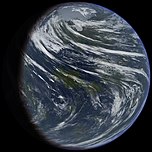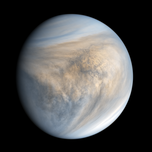Water on Venus
Water on Venus refers to the hypothesis that water was once on the surface of the planet Venus.
Early thoughts
[edit]Scientists and authors long proposed Venus was habitable, although information from the Soviet Unions Venera missions, and from the Pioneer Venus Orbiter probe, Magellan spacecraft and many more Venus studying spacecraft proved that Venus was the complete opposite.[1]
Water disappearance on Venus
[edit]Several hypotheses have been considered for how Venus lost its water. One hypothesis states that when Venus had water, solar radiation was as low as 30% less than it is today. This means the habitable zone was stretched from Venus to Earth (and possibly to Mars), before eventually Solar maxima began creating greenhouse gases in Venus’ atmosphere, making the atmosphere thicker, evaporating away all liquid water on the planets surface. Studies have proven that Venus needed liquid water three billion years ago to be able to have such high concentrations of water-related minerals and gases on its surface and in its atmosphere today. However, such studies proved that the liquids would only have lasted up until 700 million to 750 million years ago, before eventually evaporating as Venus’ atmosphere heated up from the greenhouse effect.[2]
Spacecraft discoveries
[edit]Data from the Venus Express satellite, made by the European Space Agency (ESA), took pictures of Venus, officially unveiling that Venus could’ve potentially had liquid, although how the liquid formed on Venus is still unclear.[3] New simulations using this previous data have been created at NASA’s Goddard Institute for Space Studies in New York.[1]
Other studies of Venus’ surface via various probes proved that hematite is present on its surface, proving water once interacted with Venus’ surface.[4] Hematite is an iron oxide mineral that often forms if water is present. Hematite can be formed within water-related processes as well. However, hematite could form from volcanic activity and geological formations, or could originate from comets or asteroids.[5][6]
Recent studies
[edit]
Venus’ cloud data prove that Venus' clouds contain a small amount of water, possibly proving that Venus once had a functioning water cycle.[7] Using image data from Magellan, scientists could fill lowlands of Venus’ surface area with water, leaving only Venusian continents visible. This maneuver done in the test further proved Venus could have had land, meaning that terrestrial animals could have roamed Venus at some time. The test also used measurements from the Pioneer Venus project from the 1980s. Scientists concluded from data that Venus could have been exposed to much sunlight for two months, and then no light for two months, evaporating or freezing leftover liquids on Venus’ surface. Later, this would destroy water-vapor molecules as the Sun’s ultraviolet radiation would spread rapidly on Venus over time, removing crucial elements from Venus’ atmosphere, including hydrogen, which is an important molecule in liquids. Hydrogen later was stripped from Venus, creating a runaway greenhouse effect because there was no water. GISS also proved that Venus had drier land than modern day Earth.[1]
Geological surface feature hints
[edit]The Magellan probe detected valleys and channels on Venus, which directly links to erosion of land, sedimentary deposits, and most recently and commonly volcanic activity and tectonic activity.
Most common studies of Venus’ surface via the Magellan probe prove that Venus has valleys and channels, which are not directly connected to volcanic activity, but may be linked to tectonic activity on Venus. Asteroid impacts on Venus are another common phenomenon that could have shaped Venus’ surface to evolve with these geological features, although such an asteroid would have to be huge because asteroids burn up in Venus’s atmosphere and pass through clouds sulfuric and other acids.[6]
Future investigation
[edit]
NASA’s VERITAS (Venus Emissivity, Radio Science, InSAR, Topography, and Spectroscopy) mission will help look for geological surface features on Venus, with better technology then Magellan, giving a better understanding of Venus’ past, including possible presence of water. VERITAS will also analyze surface materials and map out its surface temperatures, which could help explain the presence of water-related minerals, and may also contribute to understanding Venus’s hydrothermal activity. Instruments will spectroscope the planet’s surface. VERITAS will also use past and present data to analyze specific minerals and rocks with hydrated minerals or other water-related materials on the surface. This data could help scientists better understand past climate, geological evolution and water composition.[8]
Mechanisms to revive liquids on the surface
[edit]One way to revive such liquids on Venus’ surface is to strip greenhouse gases from its atmosphere, and replace it with breathable gases, which will release trapped heat, cooling down the planet to an average temperature like Earth's. Over time, the reduction of such greenhouse gases will thin Venus’ thick atmosphere, lowering atmospheric pressure. Satellites orbiting Venus on its day side that reflect heat can help reduce temperatures and compensate for greenhouse gases getting back into the atmosphere. Using space mirrors, similar to that of the Znamya satellite, could expose the night side of the planet to light for the same duration as the average day on Earth. Manufacturing a proper magnetosphere would also help. Using data from two Japanese scientists, it is possible to make an artificial magnetosphere around Venus by building a system of refrigerated latitudinal superconducting rings. Using this, scientists could build an artificial magnetosphere around Venus to prevent the loss of hydrogen from its atmosphere. After all the foregoing processes, hydrogen must be added to the atmosphere to help revive liquid water on the surface. Hydrogen would combine with chemicals in the atmosphere to create liquid water.
References
[edit]- ^ a b c "NASA Climate Modeling Suggests Venus May Have Been Habitable". nasa.gov. 11 August 2016. Retrieved 6 January 2024.
- ^ "Venus may have had oceans and life similar to Earth's". Phys.org. Retrieved February 11, 2024.
- ^ "Oceans on Venus Might Have Been Habitable". space.com. 24 June 2010. Retrieved 6 January 2024.
- ^ "Venus' Spectral Signatures and the Potential for Life in the Clouds". Astrobiology. 17 (4): 366–381. April 2017. doi:10.1089/ast.2016.1533. hdl:10481/63098. Retrieved 11 February 2024.
- ^ Smrekar, Suzanne M.; Stofan, Ellen R.; Hensley, Scott; Ting, Raymond H.; Treiman, Allan H.; Head, James W.; Haque, M.; DeShon, Heidi R.; van Driel, Martin; Stein, Stacy; Grimm, Robert E.; Smewing, John; Grinspoon, David H.; Hagermann, Axel; Helbert, Jörn; Piccioni, Giuseppe; Tsang, Constantinos C.C.; Limaye, Sanjay S.; Leinhardt, Zephyr M.; Sohl, Linda E.; Svedhem, Håkan; Vogt, Marcel; Świątkowska, Izabela; Romero, Vanessa; Kueppers, Michael; Rodriguez, Susana; Valencia, David; Craig, Jamie A.; Ventura-Traveset, Jordi; Banfield, Don; Barmatz, Michael; Barrett, Jeffrey M.; Blanco, Diego; Bouley, Sylvain; Bruzzone, Lorenzo; Chakraborty, Shuchita; Cisneros, Luis; Colombatti, Giannandrea; Cosmo, Mario L.; Dalmau, Rubén; DeAngelis, Silvia; Dinarès-Turell, Jaume; El-Maarry, M. Ramy; Fernandes, Vitor A.; Font, Albert; Ge, Ye; Gracia, Veronica; Hirabayashi, Masatoshi; Kestay, Laszlo P.; Kumar, S. R.; Lowry, Stephen; Luther, Ralph; Marcos, Cristina; Margot, Jean-Luc; Marusiak, Alex; Maue, Victor; Medvedev, Nikolay N.; Melosh, H. J.; Miljković, Katarina; Neumann, Gregory A.; Nguyen, Hauke; Oberst, Jürgen; Ortiz Moreno, Jose L.; Reddy, Vishnu; Reinert, Reinhold; Reufer, Andreas; Schmitz, Nicole; Schröder, Stefan E.; Schröder, Sebastian; Smirnov, Yuri; Snape, Joshua F.; Srivastava, Nalin; Szalay, Jürgen; Taylor, Stewart N.; Thompson, David R.; Tyrrell, Alex; Ugelvig, Lars R.; Vejby-Christensen (2008). "Venus Express discovers hotbed of iron-rich minerals". ESA.
- ^ a b Goudge, T. A.; Bridges, J. C.; Hurowitz, J. A.; Sefton-Nash, E.; Clarke, A. B.; Morris, R. V.; Houghton, M.; Wilson, S. A.; Smith, C. L.; Ollila, A. M.; Arvidson, R. E.; Glotch, T. D.; Bandeira, L.; Weitz, C. M.; Brown, A. J.; Hardgrove, C. J.; Lanza, N. L.; Thompson, L. M.; de Souza Filho, C. R.; Baldridge, A. M.; Maurice, S.; Rice, M. S.; Bell, J. F. (2020). "Hydrated Minerals on Endeavour Crater's Rim and Interior Flanks: New Insight into the Formation Conditions of Noachian- and Hesperian-Aged Materials". Journal of Geophysical Research: Planets. 125 (3): e2019JE006062. doi:10.1029/2019JE006062.
- ^ Jackson, Justin. "Venus could have had oceans long after life started on Earth". phys.org. Retrieved 7 January 2024.
- ^ "NASA's VERITAS Mission to Map Venus". NASA Jet Propulsion Laboratory. Retrieved February 11, 2024.


